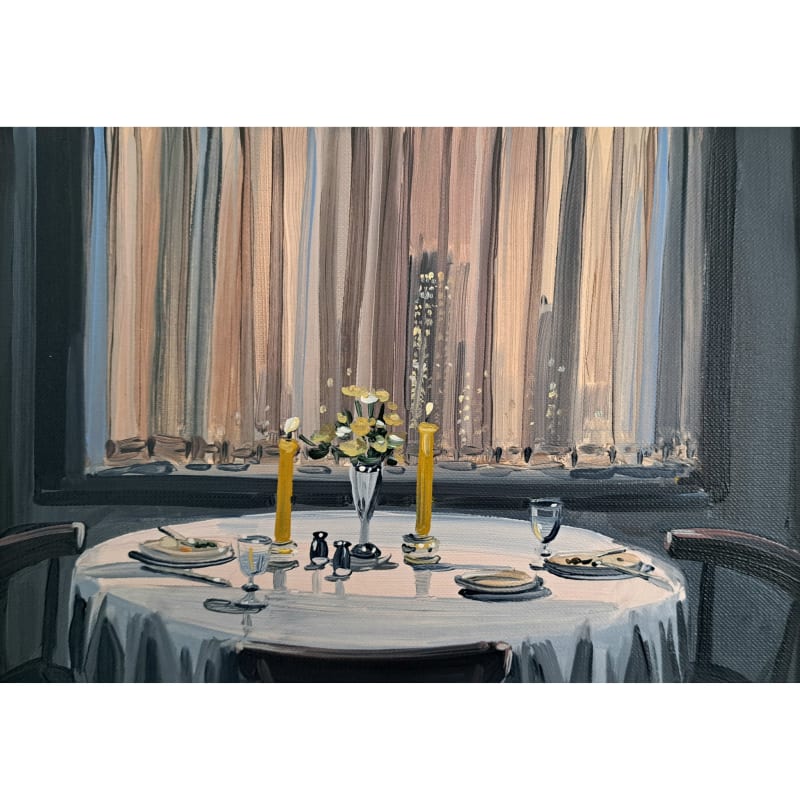Ciara Roche received her MA Art Research and Collaboration (2019) and a BA
in Visual Arts Practice (2015) from the Institute of Art Design and
Technology/IADT. Roche is a recipient of the 2022 Next Generation Award,
numerous Arts Council & Art Links Bursaries and won the Éigse Graduate
Prize for outstanding work in VISUAL with Carlow Arts Festival in 2020.
She has had solo exhibitions at the Ashford Gallery, RHA (2022); mother’s
tankstation, Dublin (2021); The LAB, Dublin (2019); and St Carthage Hall,
Lismore Castle Arts, Waterford (2016). A major exhibition of her work was
held at the Butler Gallery, Kilkenny 2024.
Ciara Roche's small paintings on paper depict unnerving, cinematic
inspired scenes—seemingly ordinary interiors that portray a world held in
a permanent state of suspense. This frequent sense of unease in Roche’s
paintings could be seen as a sort of critique of the hugely capitalistic
world we live in. Of the dark side of situations, Roche writes that her
solution is ‘to paint those fears, acknowledging the things that might
happen, like exploring different versions of my life’. Viewing her works
is like entering an uncanny world of suspense made up of light and shadow.
Her lushly rendered paintings, made with wet and quickly applied oil paint
to create a sense of luminosity and movement on the surface, capture
timeless moments for the viewer to ponder.
Claire Keegan writes, The works of Ciara Roche were first introduced to me by the writer and critic Niall MacMonagle who suggested her painting, Study No 5, as the cover design for Faber’s edition of So Late in the Day. It characteristically depicted a bedroom with no figures. Within was a plain wardrobe, a bed, a lamp, a blue shirt draped over the radiator.
On my first visit to her Wexford studio, near Enniscorthy, I encountered a good- humoured, unpretentious woman with three happy greyhounds she’d rescued who were not allowed inside. It was a wet day and when we entered the studio, the paintings immediately closed in. A large canvas in shades of tannish brown dominated the far wall, depicting a conference room with a large glass table and empty chairs. It for some reason, put me in mind of war, of men in charge meeting to make decisions and take advantage, make advances. A large canvas in shades of blue in what looked to me like Sydney (where, it turns out, Roche has spent some time), dominated the adjacent wall. I felt it to be an evacuation scene, a disinterested view through clear glass of citizens leaving. There was a piano with no one playing, no hope of it being played, a queue of cars pushing against each other, all leaving town for safety, it seemed. Hopper’s influence is evident and Roche claims Mairead O’hEocha, whose work she first viewed at the Douglas Hyde Gallery in 2011 as an early influence. Other painters she often goes to are Leonora Carrington, John Singer Sargent, Joaquin Sorolla – and more contemporary artists: Gregory Crewdson, Luc Tuymans and Louise Giovanelli. Film is also a huge influence, and some of these paintings, The Garden, Greenhouse and Twin Room are responses to John Glazer’s marvellous and disturbing film, The Zone of Interest, which is set and was filmed at Auschwitz.
There’s no fear of crowds or any form of overcrowding in these works, not a citizen to be seen – and yet, despite this, it sometimes feels all too peopled, that people are expected or coming or gone, that preparations have been made and perhaps abandoned and all that remains is what’s left behind, the property, its rooms, the furnishings. The paintings’ elegance is in the omissions and absences, and the effect is both disturbing and mysterious. The works exhibited in honeymoon are not paintings to soothe or prettify. In The Landing, one feels the staircase to be hazardously steep. On the descent, one feels warned to use the bannister, to hold on. In other paintings, despite the upholstery, the softnesses, (the curtains, the bedlinen, the tablecloths, the wine, the yellow lamplight and yellow, lighted candles), whose comforts could dominate, one is not so much comforted as taken over by Roche’s unobtrusive obsession with glass, with what is shiny, clean and breakable. She presents herself against windows, mirrors, a windscreen. Even the sunset over the sea feels like it could be shattered or broken and won’t last. No sunset does. And there is money in this work, a sense for what is expensive -– but what is the money for and what good is it? – the paintings seem to ask.
One can’t but admire the generosity in her hand, the artist’s willingness in these paintings to step up to what’s before us, Roche’s courage. What I most appreciate, apart from her obvious skill as a painter, is akin to what good prose does; how she leaves room for us to go in and imagine, to use our intelligence, our own lives, to become skilled and wondrous in these unsettling spaces she has called us towards. Be complacent at your own peril, they seem to say. Watch your step. In every painting I hear, in the background, the noise of a siren or an alarm going off. Perhaps, if we stand for long enough, a black smoke will start drifting past those clear windowpanes. The sun will sink down into the sea and the sea will grow dark. Someone might fall. These paintings will stay with me for years to come . . .
